Overlanding Scotland Part 2: Dead-End Mallaig to the Remote Coastal Camp
I chase the sun from dawn in Glencoe to twilight in Skye for an epic evening of mist, mountains, and midnight storms.
This is Part 2 of a 3-part article series on Overlanding Scotland. Click here to read Part 1.
By the time I emerged from my tent, the rain had cleared the mountains of Glencoe. The sun was starting to peek over the horizon, and I appeared to be among the first ones to awaken in the campground.
A pack of raggedy sheep cautiously eyed me from across the road as I brushed my teeth near the front of the Defender. I shimmied my way around the side and roof of the truck to pack up my tent.
After a quick cup of hot green tea and some time to admire the mountains around me, I bid farewell to the camp host and headed back down the single-track road to the main highway.
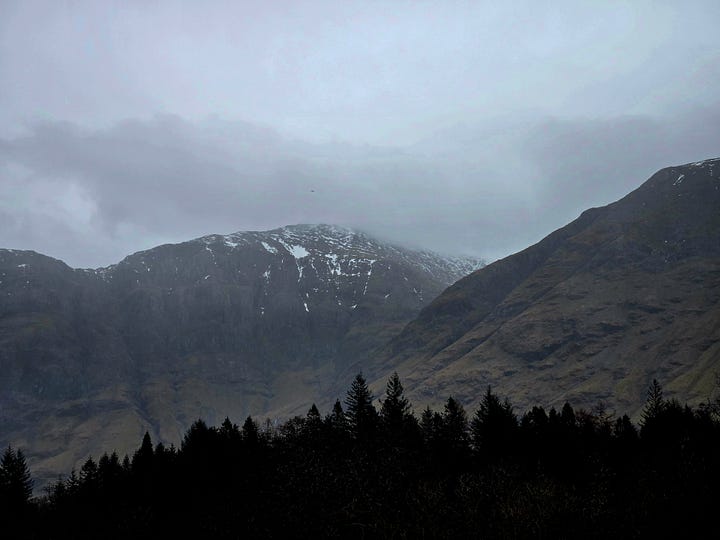
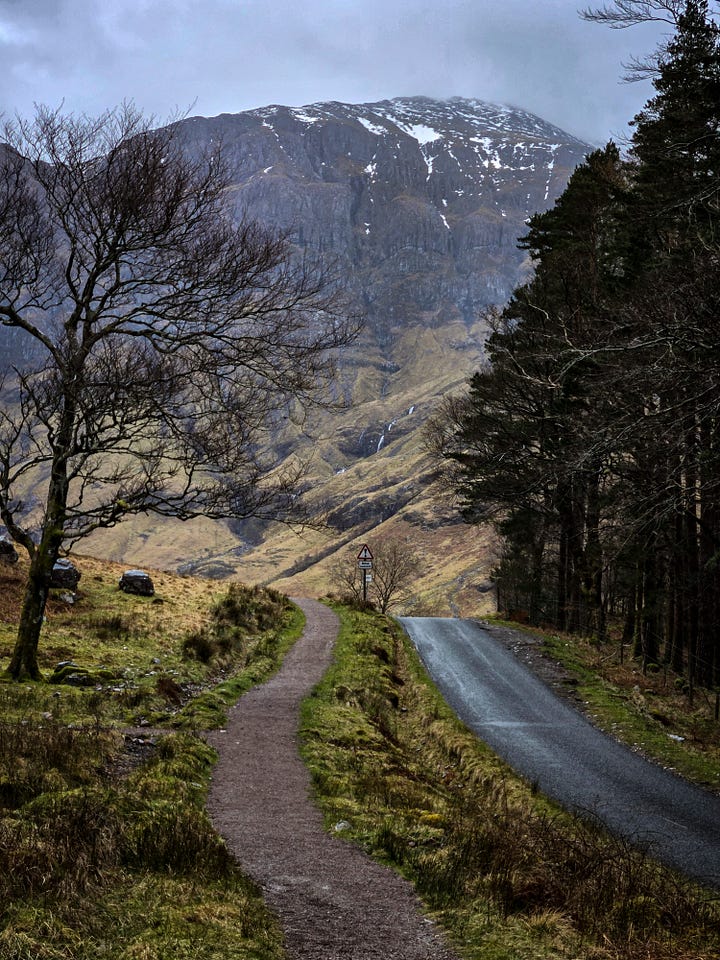
Dead End in Mallaig
After a couple of near-accidents and learning a couple of lessons about the rules of the road yesterday, I found driving in Scotland to be much easier. I had far more confidence about driving on “the wrong side” and less fear of getting in a head-on collision.
My plan for day two was to get to the Isle of Skye as quickly as possible so I could enjoy some hiking.
I figured I’d take a different route down to the village of Mallaig, where I could catch the ferry to Armadale on Skye. I knew beforehand that the traditional route on A87 across the Skye Bridge would be more direct and a bit faster. However, driving the Defender on a ferry and bouncing across open water seemed a bit more adventurous than just rolling across a bridge.
Driving in Scotland was beautiful, but driving times were far greater than I anticipated. I knew the roads would be slow and windy, but Google Maps calculates things according to the posted speed limits. And while many of these roads posted a speed limit of 60 miles per hour, I barely felt comfortable exceeding 30 in many places. As a result, one-hour drives turned into two, two-hour drives turned into four, and everything took notably longer.
I traveled the miles swerving roads of the Glencoe Valley towards the coast, skirting lochs, rivers, valleys, and small villages. There was so much to see, but time was tight. I’ve taken many trips where if you stop at every beautiful site, it could take ten hours to travel 100 miles.
I passed through the town of Fort William, hugged the shore of Lock Eli, and drove another hour to reach the end-of-the-highway village of Mallaig. Expecting to see some bustle down by the docks, few people were around, and the gate was closed. It turned out the ferry wouldn’t be running for another two weeks. Shit! Two hours of drive time down what was essentially a dead-end road only to find out the ferry was shuttered. I guess that’s what you get for trusting Google Maps.
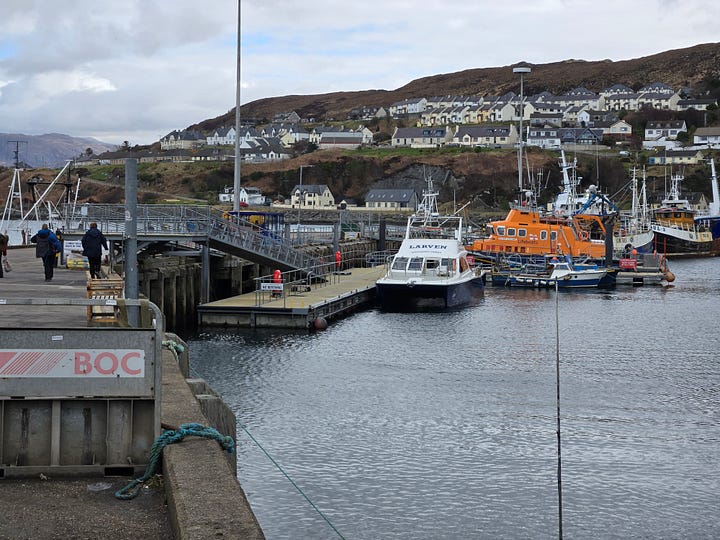
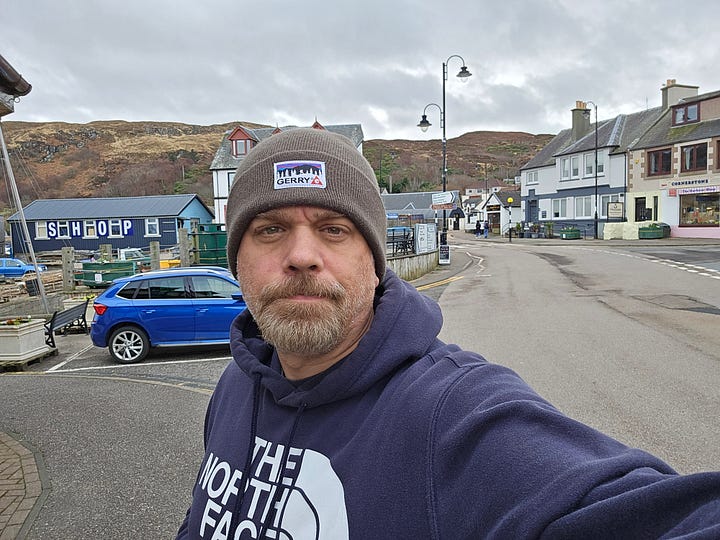
I’ve traveled so many places alone and have encountered so many situations that I always find a way to figure things out. There’s usually a bypass, a workaround, an alternative, or some creative option. And if worse comes to worse, you can usually make things happen by greasing a palm or two.
Had this been Nicaragua or Thailand, there would have been a shirtless, dirty man willing to take me and the truck across on a construction barge for $27.
But this was Scotland. It had regulations, and there were no transportation hustlers down by the waterfront. I looked at the five-mile water crossing and had to accept the reality that there wasn’t a damn thing I could do about it. There was no choice but to suck it up and backtrack nearly two hours back to Fort William, where I could take the other road back to Skye, the road I should have taken to begin with.
I grabbed a coffee from a local store and walked near the docks to stare off into the distance in a strange state of both self-loathing and awe of nature.
Reach for the Skye
Isle of Skye is one of the most magical places in Scotland. Dramatic cliffs, rugged landscapes, and mist-shrouded peaks draw hikers and adventurers from around the world. The Cullin mountain range dominates the landscape and towers over a patchwork of lochs, waterfalls, and Mooreland. Steeped in history and folklore, Skye is also dotted with ancient ruins and medieval castles like the Dunvegan Castle, which was home to the MacLeod Clan for more than 800 years.
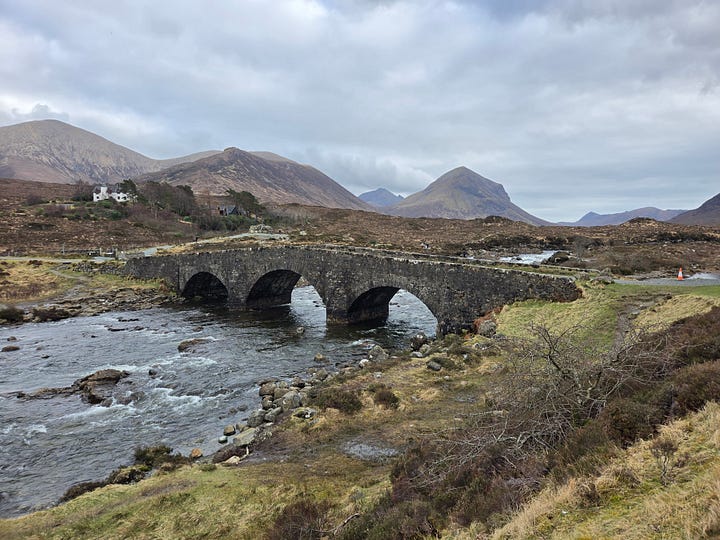
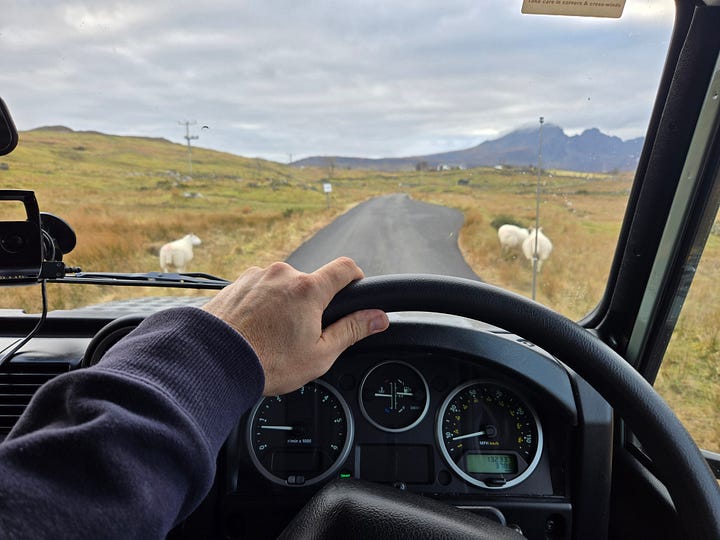
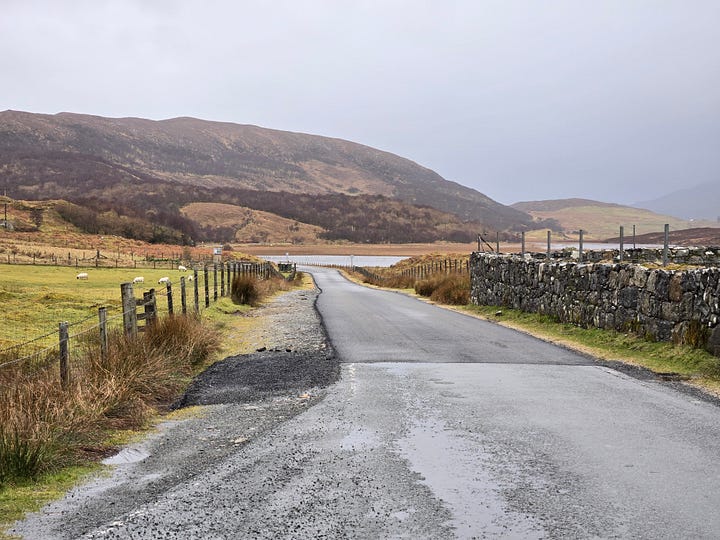
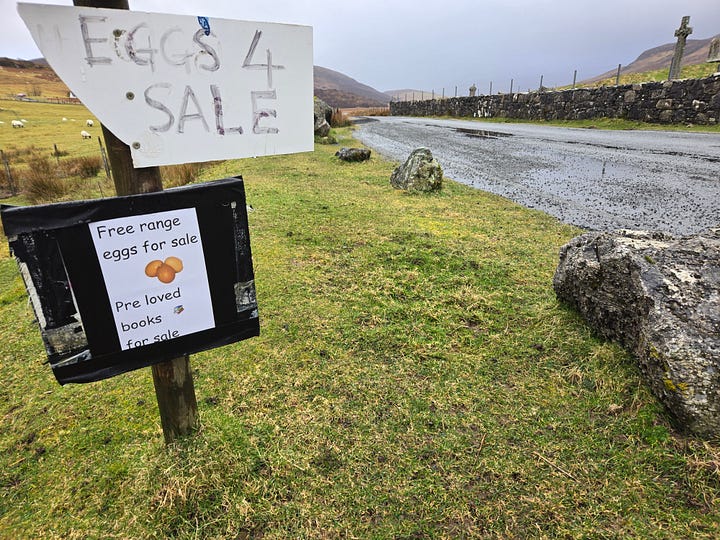
I didn’t reach Skye until well past 3 p.m. I took a quick ride out to Sligachan, drove past some sights, and stopped off at a roadside joint in the village of Broadford for some venison pizza. Thumbing through the waypoints Duncan had programmed into the GPS, I looked for a good campsite for the night. Back at Scotland Overland headquarters, he had told me about finding a camp on the shores of Lock Slapin. Well off the main road and past the last houses, it looked like the perfect place for the evening.
I followed the GPS path off the main road and through some small farming communities. The road got a bit rougher, and beyond the last house, the cascading hills opened up, revealing the coast in the distance. Fogged rolled in, and two red stags quickly ran across a hilltop in front of me.
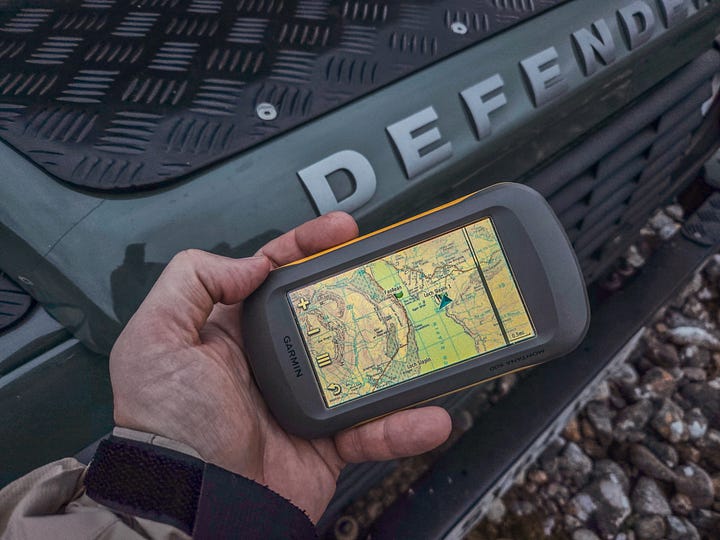
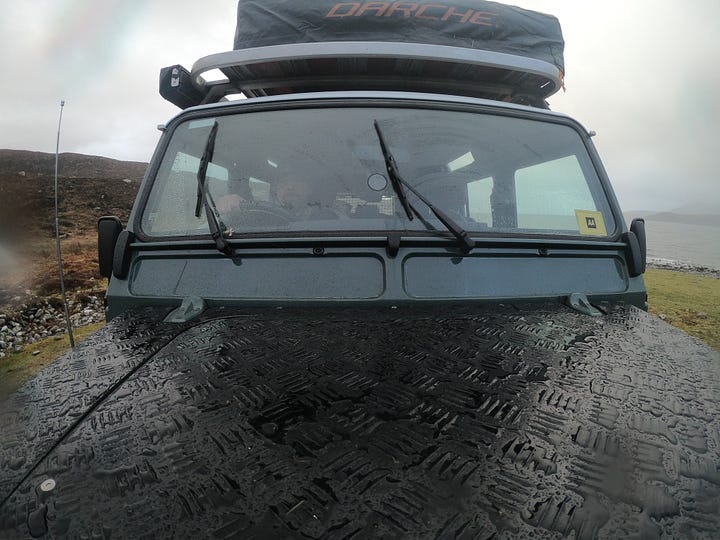
I continued driving towards the coast, bouncing up and down the rickety roads with the Defender’s wheels and straight axles bouncing over the potholes. There were countless sheep, perhaps thousands, scattered about the landscape. Some were painted pink, others blue, the farmer’s way of marking where their flocks belonged.
The road ended in a grassy field near the shore of the loch. I found a 4x4 trail
that cut south down the coast and traveled it briefly for a bit. I climbed a high ridge in the Defender to get a better viewpoint of the landscape. Staggered layers of small mountains ringed the horizon, and the rough waters of the loch before me churned like a washing machine.
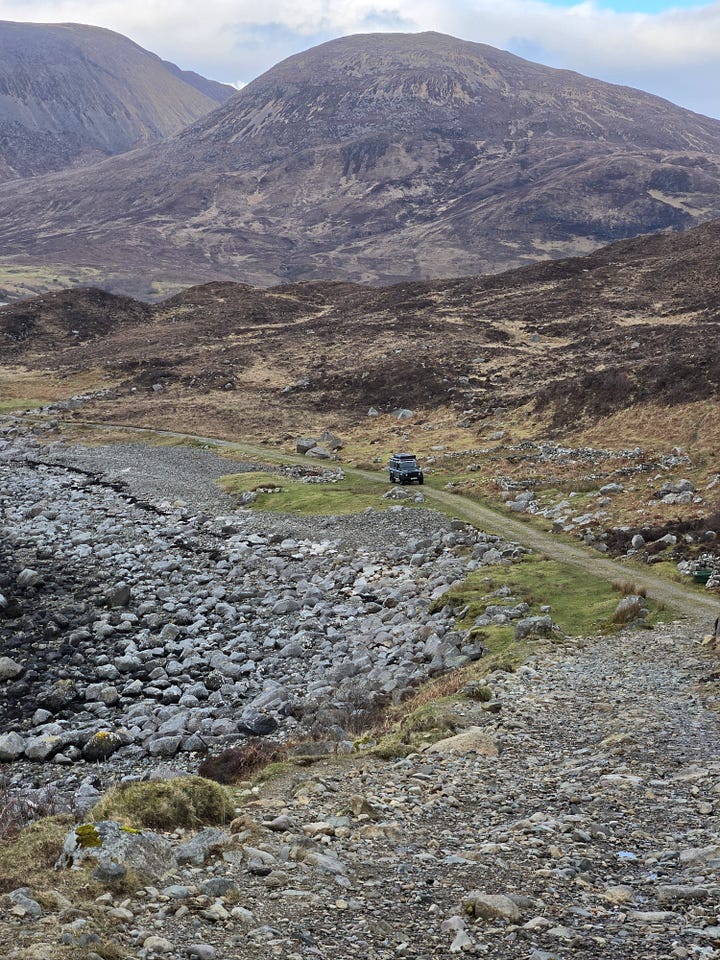
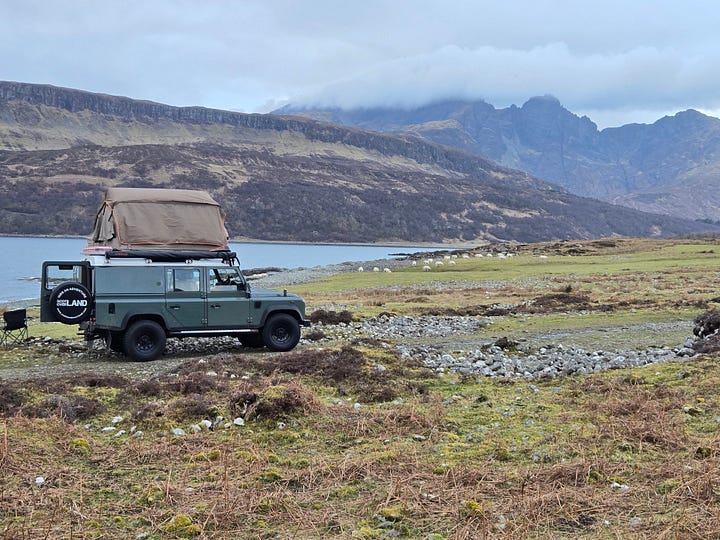
I thought this might be a good camp. But the winds were already roaring and would likely grow worse over the evening. I backtracked down the ridge to the clearing I had passed and settled on a patch of rocks to make camp for the night. I grabbed some large rocks from the area and drove the driver-side front wheel of the Defender upon them to level out the truck.
Upon killing the loud diesel engine, I was immediately struck by the sounds of the Scottish highlands. Waves pounded the shore, winds howled across the loch, and off in the distance, I could hear the bahs of a herd of two dozen sheep gathered down by the shore. They all rose to attention and eyed me cautiously as I climbed onto the Defender’s hood to unbuckle the tent and pull out my bed for the night.
The Coastal Camp
In my travels, I’ve camped on quite a few remote beaches. There’s something magical about being within earshot of the crashing waves. But unlike many of the tropical beaches I’ve slept on in places like Costa Rica, Panama, Malaysia, and Florida, the shore of Loch Slapin was cold and dark. It wasn’t a place to dip into the warm ocean waters and enjoy some rum in the sun.
At least for the time I was there, I found Scotland’s weather and landscape a bit depressing. With dark skin and a body seemingly designed for heat, I’m at home shirtless and barefoot in tropical environments, beaches, and the sun. Thick coats, hats, boots, and wool socks make me feel confined. While I had the clothing to keep me warm and dry, sitting out at camp in the evenings was less than pleasant.
Nevertheless, I was here and determined to embrace the experience. I pulled a chair from the back of the Defender, grabbed an Innis and Gunn beer, and took in the sights and sounds of Skye. Across the lock, I could occasionally see headlights zooming up and down the mountain path, but on this side, there was nothing—just me, the sheep, and a couple of red stags I saw on the way in.
This is exactly the kind of seclusion I seek when overlanding. I enjoy people, and I’m not a recluse. But there is something magical about being the only human for miles. Being alone in the wilderness brings me an overwhelming sense of freedom. My heart rate drops, I breathe easier, and any sort of worry, stress, or anxiety I ever had just disappears. Freedom from schedules, technology, the outside world, norms, protocols, and expectations. When you’re camping alone in the wilderness, you just exist in the moment. I sit, breathe, contemplate life, and immediately have a deeper connection with the Earth and myself. It’s my version of going to church.
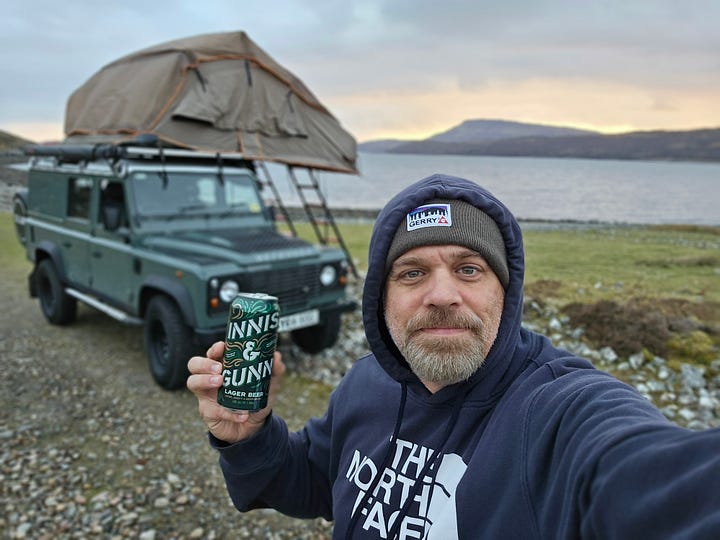
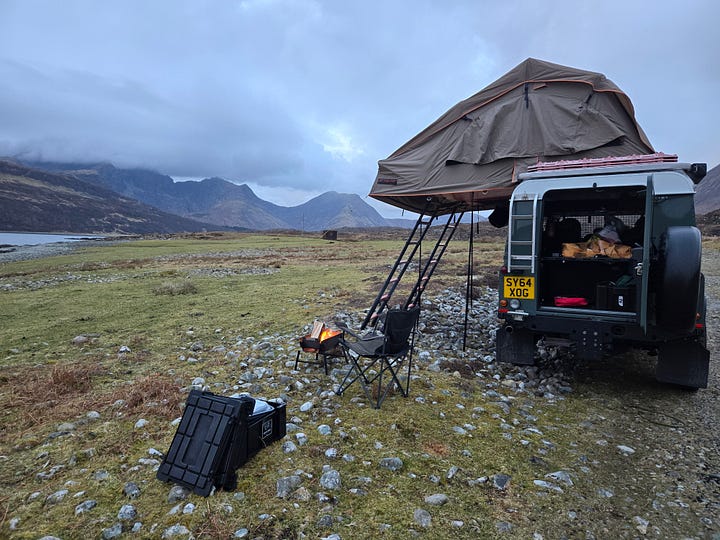
The clouds rolled over the mountains and down into the lock below, almost like a waterfall in the sky. They moved with little rhyme or reason. I had done a little sailing and learned about shifting winds, but this was all over the map. Breezes blew from the East, then from the South, then from the North. At times, they seemed to blow straight down from overhead.
The sun slowly disappeared into the horizon, and it got colder by the minute. I started to prepare a fire in the portable fire pit that Duncan had provided with some fine cedar wood I had picked up at the Red Squirrel campsite. While Scotland has some forests, most of the Highlands are barren and not the best place for scavenging firewood. Even if you’re lucky enough to come across something to burn, it’s likely waterlogged from the endless rain.
I set up my cook site and prepared a giant filet of salmon with Jasmine rice. I opened a bottle of Shriaz that Liam had bought for me down by the Red Squirrel Campsite. The winds were so high they blew some rice off my fork every time I took a bite, but it was a good meal.
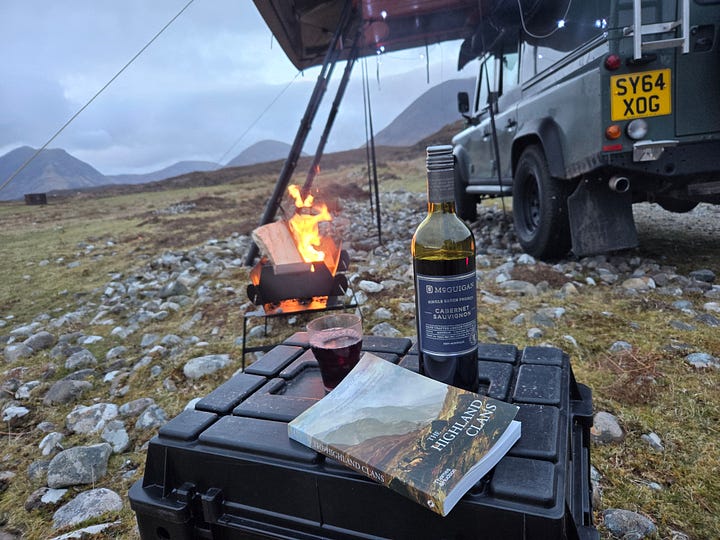
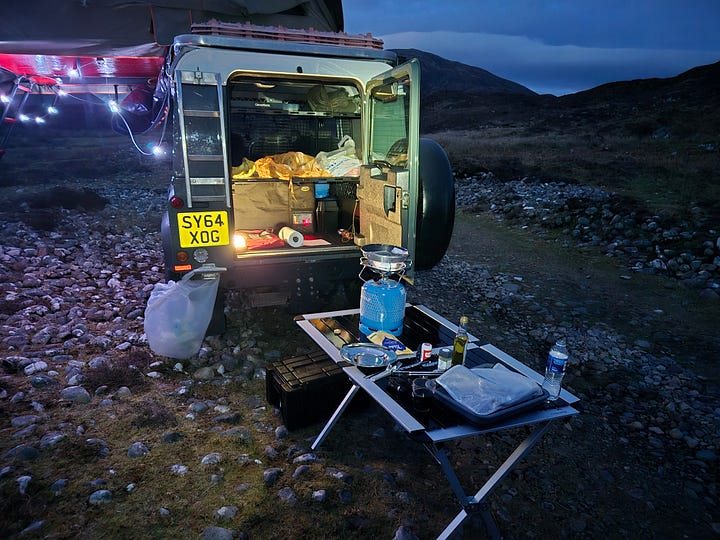
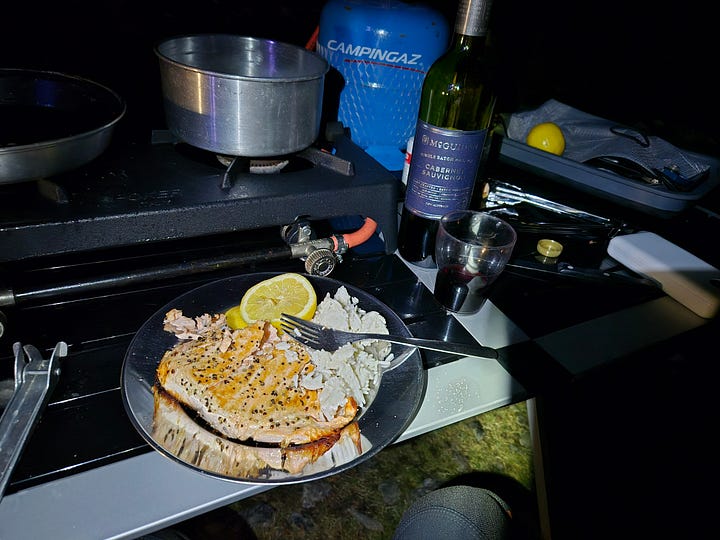
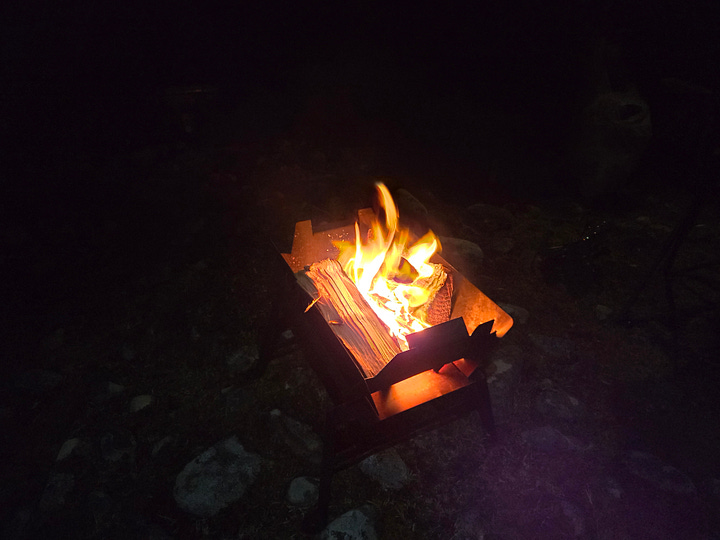
I stoked the fire with just enough wood to keep it going, yet not too much so I could stretch it out for the night. It was a windy evening, but still a better night than the previous one. At least I could sit outside. I grabbed a book I had bought just for this trip. The Highland Clans documents nearly 1,000 years of the history of the clans, from their Celtic origins to the coming of the Romans and the Battle of Culloden in 1746. I like to try to learn more about places by taking select books to read on my travels. But often, much of the history of places is so disconnected from modern times that it’s merely a ghost of the past.
It was only an hour or so before the rains started. I tried to continue reading, enjoying the fire from underneath the overhang of the tent. I was in waterproof gear, and I still had more wine. But as the rain turned sideways, it started to reach the book, and my vision was blurred by raindrops blazing across the beam of my headline.
It was time to admit defeat and head up into the tent. I grabbed water, my book, and a few personal items, then climbed the ladder.
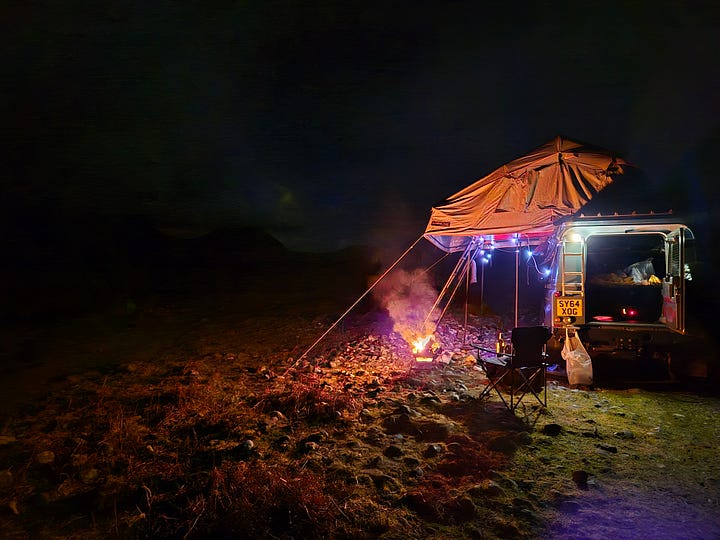
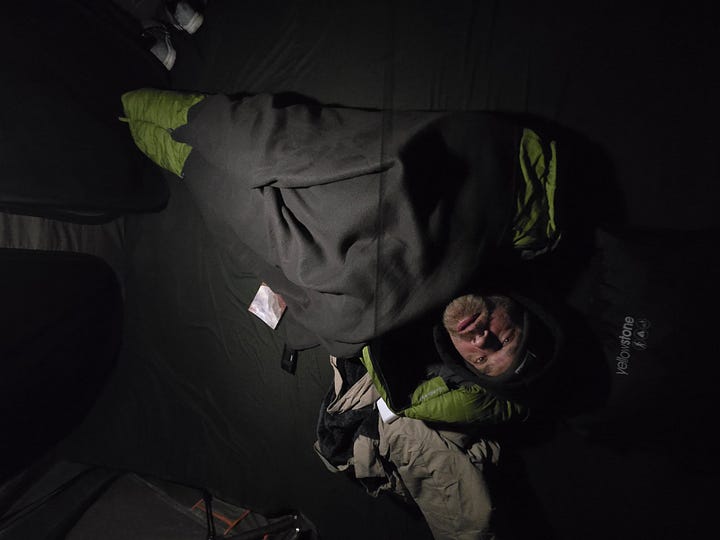
I started to tuck in for the night, but big winds roared across the lake, and rain pelted the tent. It got louder and louder, shaking both the tent and the truck. I’ve been in several rooftop tents in high winds, and it can get loud and unnerving. Your emotional mind tells you you may get blown off the truck in the middle of the night. What if your parking brake and chock failed, and the winds made the tent a sail and shook the truck just enough to roll downhill? What if the tent collapsed on you, and you couldn’t get out or fell from the truck in the process? What
But the rational mind tells you that’s highly unlikely. You may be in for a loud, rough night, but chances are you’ll be fine.
I pulled my hat over my ears, put my hoody over that, and then nestled my head into the mummy bag, warming myself and muffling as much sound as I could. At some point during the night, my mind let everything go.









